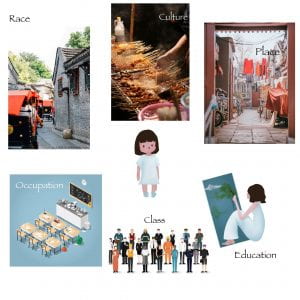From my perspective, I feel race, place, culture, education, occupation, and class are the dominant influence in my life. For the race, I think my body shape and skin color were made different from other race’s people. I consider my self more suitable for pure color. At the time I started to study abroad, Chinese style clothes more attract me. It’s because I’m Chinese, and I was far away from my hometown. So when I was in another country, and I saw a cloth have some element of my culture, I will more like to buy it. From another point of view, I find out since I come to America to study, I was more accepted to wear some tight and explore cloth. But when I go back to China every vacation, I’m still kind of afraid to wear those short skirts and cropped top because there are still many people who consider the women who wear explore cloth are “easy” in Asian countries. And I don’t like people glaze at me because of what I wear. So my style is changing as the place is different. Like the book Fashion and Cultural Studies, Susan Kaiser mentioned: “Because individuals do not accomplish this exploration completely by themselves—because they think about others as they get dressed, and because they rely on feedback from others— style-fashion-dress is a social process.” (Susan Kaiser, page30) I cannot completely ignore other judgment when I was dressing. Education and occupation and class are tightly related to my situation. My parents all work in the science field. They always support my decision, and their income can help me in having a good education. I study old painting since I was ten, and then they encourage me to study abroad, which influenced my dressing style. Since I study oil painting for a long time, I was more into the clothes that have a soft and feminization shape. And the experience of study in parsons did influence me the way that I consider what a suitable cloth is. After I learn more knowledge about fashion and clothes, I believe the quality and design concepts are much more important than anything.
Citation:
Antonio, Jayme. “Malatang.” Malatang, www.jstor.org/stable/pdf/41514845.pdf?seq=1#page_scan_tab_contents.
“Isometric Chemistry Classroom Illustration #Chemistry, #Isometric, #Illustration, #Classroom in 2020: Chemistry Classroom, Isometric Art, Illustration.” Pinterest, 28 Jan. 2020, www.pinterest.com/pin/811351689095109442/.
“Illustration Vector of Various Careers and Professions Free Vector: Vector Free, Social Media Icons, Illustration.” Pinterest, www.pinterest.com/pin/491666484319649761/.
Xoxo, Angie. “7 Unique Things To Do And See In Beijing.” 7 Unique Things To Do And See In Beijing, www.thelovelyescapist.com/things-to-do-beijing/.
